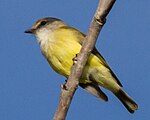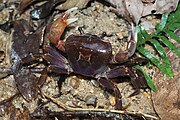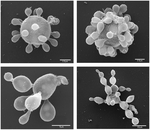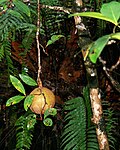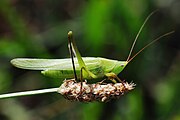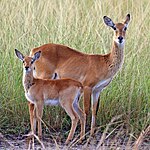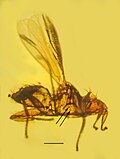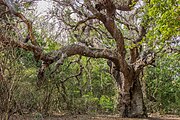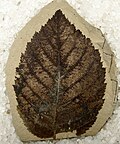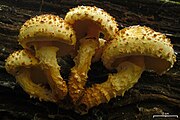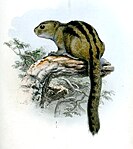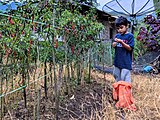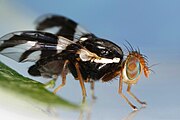User talk:Edibobb/Archive 2
| This is an archive of past discussions about User:Edibobb. Do not edit the contents of this page. If you wish to start a new discussion or revive an old one, please do so on the current talk page. |
| Archive 1 | Archive 2 |
August 2019 Tree of Life Newsletter
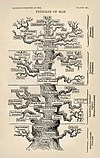
- August 2019—Issue 005
- Tree of Life
- Welcome to the Tree of Life newsletter!
|
|
|
|
  Guest column by Thomas Shafee (Evolution and evolvability), Editor in Chief of WikiJournal of Science
Firstly, WikiJSci can be a complementary system for FA review (getting external review, input, and validity). When an Wikipedia article is nominated (via WP:JAN), journal editors go out to non-Wikipedian academics and researchers who have published on the subject on the last five years and invite them to give feedback comments (e.g. Peripatric speciation and Baryonyx). The resulting changes can then be integrated back into the Wikipedia article.
Getting more editors involved in Wikipedia is always a high priority. WikiJSci can also be a way to encourage new people to contribute articles (especially on missing/stub/start topics). An example of an article that was written from scratch by a group of non-Wikipedians is Teladorsagia circumcincta. This not only resulted in a new Wikipedia page on an underdeveloped topic, but introduced the idea of Wikimedia contribution to a group of people who had previously never considered it.
The journal can be a way to get multimedia content reviewed or encourage contribution. The same approach could be easily adapted to sounds (e.g. frog mating calls) or videos (e.g. starfish feet motion). It also allows for tracking of those images in new articles via Altmetric (this example has >200, which is bananas). There aren't any biology examples in WikiJSci yet, but the sister medical journal has published a few summary diagrams, photography, and image galleries. Examples include this gallery by Blausen Medical or the diagram of cell disassembly during apoptosis.
For those interested in other Wikimedia sister projects, there's also broad scope for interactions with the WikiJournals. Perhaps peer reviewed teaching resources could be useful to sit alongside sets of Wikipedia articles and be integrated into Wikiversity courses (like this or this)? Can sections of Wikidata & Wikispecies be peer reviewed? What are the potential avenues for integration with WikiCite, WikiFactMine, Scholia, etc.? Currently, WikiJSci is aiming to be very flexible and try out different formats so long as they can be externally peer reviewed. For more info, see the 2019-06-30 Signpost article and the current sister project proposal. |
|
1) Enwebb: You're very prolific with DYKs, with over 2,000 nominations credited (in fact, I'll highlight which DYK nominations this month were yours below). What made you become so involved in this part of Wikipedia? Why should Tree of Life editors nominate articles for DYK?
2) Enwebb: I noticed that your DYK nominations reflect a diverse array of flora and fauna, from trees, marine invertebrates, birds, fishes, and mammals. How do you decide what to work on?
3) Enwebb: Which of your Wikipedia accomplishments are you most proud of?
4) Enwebb: What motivates you to keep contributing? What's your 10,000 ft view (pardon the non-SI) of the community and Tree of Life?
6) Enwebb: How did you first become interested in natural history?
|
|
You are receiving this because you added your name to the subscribers list of the WikiProject Tree of Life. If you no longer wish to receive the newsletter, please remove your name.
Sent by ZLEA via MediaWiki message delivery (talk) at 15:43, 1 September 2019 (UTC)
September 2019 Tree of Life Newsletter

- September 2019—Issue 006
- Tree of Life
- Welcome to the Tree of Life newsletter!
|
|
|
|
|
|
5
10
15
20
'02
'04
'06
'08
'10
'12
'14
'16
'18
Tree of Life subprojects and task forces by start year and whether currently considered active or not This month saw a vanishingly rare occurrence for the Tree of Life: a new WikiProject joined the fold. WikiProject Diptera, however, is also unusual in being a classroom project. Whether or not this project will stay active once the semester ends remains to be seen. It does not bode well, however, that WP:WikiProject Vespidae—a creation from the same instructor at St. Louis University—faded to obscurity shortly after the fall semester concluded in 2014. WikiProject Vespidae is defunct and now redirects to the Hymenoptera task force of WikiProject Insects. Since 2014, the Tree of Life has seen a string of years where one or zero projects or task forces were created. The only projects and task forces created since then are WikiProject Animal anatomy (2014), Hymenoptera task force (2016), Bats task force (2017), WikiProject Hypericaceae (2018), and now WikiProject Diptera (2019). The year 2006 saw the greatest creation of WikiProjects and task forces, with fourteen still active and the remaining six as "semiactive", "inactive", or "defunct". |
|
You are receiving this because you added your name to the subscribers list of the WikiProject Tree of Life. If you no longer wish to receive the newsletter, please remove your name.
Sent by ZLEA via MediaWiki message delivery (talk) at 22:26, 1 October 2019 (UTC)
Qbugbot
I am impressed by the stubs such as Eucrada humeralis produced by your Qbugbot and am expanding a few of the articles. Cwmhiraeth (talk) 10:24, 16 October 2019 (UTC)
- Thank you! Bob Webster (talk) 13:02, 16 October 2019 (UTC)
October 2019 Tree of Life Newsletter

- October 2019—Issue 007
- Tree of Life
- Welcome to the Tree of Life newsletter!
|
|
|
|
|
|
By request from another editor, this month I wrote an overview of ways that content is featured on Wikipedia. Below I have outlined some of the processes for getting content featured: Did You Know (DYK)What is it: A way for articles to appear on the main page of Wikipedia. A short hook in the format of "Did you know...that ___" presents unusual and interesting facts to the reader, hopefully making the reader want to click through to the article How it works: The DYK process has fairly low barriers for participation. The eligibility criteria are few and relatively easy to meet. Some important guidelines:
The process for creating the nomination is somewhat tedious. Instructions can be found here (official instructions) and here ("quick and nice" guide to DYK). Experience is the best teacher here, so don't be afraid to try and fail a few times. The last few DYK nominations I've done, however, have been with the help of SD0001's DYK-helper script, which makes the process a bit more streamlined (you create the template from a popup box on the article; created template is automatically transcluded to nominations page and article talk page) Once your nomination is created and transcluded, it will need to be reviewed. The reviewer will check that the article meets the eligibility criteria, that the hook is short enough, cited, and interesting, and that other requirements are met, such as for images. If you've been credited with more than 5 DYKs, the reviewer will also check that you've reviewed someone else's nomination for each article that you nominate. This is called QPQ (quid pro quo). You can check how many credited DYKs you've had here to see if QPQ is required for you to nominate an article for DYK. Good Article (GA)What it is: A peer review process to determine that an article meets a set of criteria. This adds a How it works: You follow the instructions to nominate an article, placing a template on its talk page. Anyone can nominate an article—you don't have to be a major contributor, though it is considered polite to inform the major contributors that you are nominating the article. The article is added to a queue to await a review. In the ToL, it seems that reviews happen pretty quickly, thanks to our dedicated members. Once the review begins, the reviewer will offer suggestions to help the article meet the 6 GA criteria. Upon addressing all concerns, the reviewer will pass the article, and voilà! Good Article! Advice to a first-time nominator: Look at other Good Articles in related areas before nominating. If you're unsure about nominating, consider posting to the talk page of your project to see what other editors think. You can also have a more experienced editor co-nominate the article with you. Featured Article (FA)What it is: An exhaustive peer review to determine that an articles meets the criteria. This adds a How it works: You follow the instructions to nominate an article, placing a template on its talk page. Nominated articles are usually GAs already. Uninvolved editors can nominate, though the article's regular editors should be consulted first. Several editors will come by offering feedback, eventually supporting or opposing promotion to FA. A coordinator will determine if there is consensus to promote the article to FA. For an editor's first FA, spot checks to verify that the sources support the text are conducted. Advice to a first-time nominator: The Featured Article Candidate (FAC) process is a bit intimidating, but several steps can make your first one easier (speaking as someone who has exactly one). If you also did the GA nomination of the article, you can ask the reviewer for "extra" feedback beyond the GA criteria. You can also formally request a peer review and/or a copy edit from the Guild of Copy Editors to check for content and mechanics. First-time nominators are encouraged to seek the help of a mentor for a higher likelihood of passing their first FAC. Good and Featured Topics (GT and FT)What it is: It took me a while to realize we even had GT and FT on Wikipedia, as they are not very common relative to GA and FA. Both GT and FT are collections of related articles of high quality (all articles at GA or FA, all lists at Featured List). GT/FT have to be at least 3 articles with no obvious gaps in coverage of the topic, along with other criteria. For GT, all articles have to be GA quality and all lists must be FL. For FT, at least half the articles must be FA or FL, with the remaining articles at GA. How it works: Follow the nomination procedures for creating a new topic or adding an article to an existing topic. Other editors weigh in to support or oppose the proposal. Coordinators determine if there is consensus to promote to GT/FT. Advice to a first-time nominator: There are very few GT/FT in Tree of Life (5 GT and 11 FT). Most of the legwork appears to be improving a cohesive set of articles to GA/FA. |
|
You are receiving this because you added your name to the subscribers list of the WikiProject Tree of Life. If you no longer wish to receive the newsletter, please remove your name.
Delivered by MediaWiki message delivery (talk) at 03:34, 3 November 2019 (UTC) on behalf of DannyS712 (talk)
ArbCom 2019 election voter message
Further reading for jumping spiders
Hi Bob! This is a very minor point, so I'm moving it here instead of the Qbugbot discussion. You mentioned that Qbugbot left the source "A genome-wide phylogeny of jumping spiders (Araneae, Salticidae), using anchored hybrid enrichment" (2017) in Further reading because "I think it's worth including for the species of this genus." It's a bit strange that you chose this paper rather than Maddison's earlier "A phylogenetic classification of jumping spiders (Araneae: Salticidae)" (2015). Maddison 2017 is basically just a minor footnote to the seminal Maddison 2015. Maddison 2015 lays out the entire modern taxonomy of the jumping spider family. It would probably be worth including Maddison 2015 as Further reading for all jumping spider articles (family Salticidae), but I don't really see the value of Maddison 2017 (which is basically just tying up some loose ends from Maddison 2015). I also realize this may be a moot point, so feel free to just ignore me in that case :) Kaldari (talk) 19:48, 4 December 2019 (UTC)
- That's a good point. I had not included Maddison's 2015 paper anywhere, and looking over it, I agree it's a much better source. I've limited the 2017 paper to ranks genus and above (which won't be used much since most of those pages already exist), and added the 2015 paper for future Salticidae pages in Further Reading. Thanks for the help! Bob Webster (talk) 20:32, 4 December 2019 (UTC)
Taxonomic synonym redirects
Hello! Thanks for noticing that Chapra (skipper) is not a valid taxon and ought to be redirected to Pelopidas (skipper). I saw however that you left a line stating "Chapra is a taxonomic synonym of Pelopidas." below the redirect in plain text. This is usually handled through templates, in this case {{R from alternative scientific name}}. Those templates have the additional benefit of immediately adding the redirect to the relevant redirect category. (The template does not state the exact taxon it is synonymous to, but it also doesn't quite need to, as that can fairly easily be inferred from the redirect target. In highly complex cases, it's sometimes useful to leave a hidden note explaining the choice of target, but for a fairly straightforward "redirect is synonym of exact target article", that's rarely needed) Again, thanks for your efforts. :) Cheers, AddWittyNameHere 18:54, 24 December 2019 (UTC)
- Thanks for the information. I'll try to do that properly in the future. I ran across that when I was looking at some Arthropod articles on invalid taxa. There are about 1000 articles on synonyms that probably need to be moved or redirected. Bob Webster (talk) 19:20, 24 December 2019 (UTC)
- You're welcome! Yeah, that's how most of those get fixed: someone happens to run across them. Honestly not surprised to hear so. If anything, I'm fairly sure that just on Lepidoptera alone, we probably have that number of invalid taxa lingering about, especially if including the stuff that needs movement rather than redirection. With 100k+ articles, some folks in the earlier days of the wiki working from outdated or otherwise not quite reliable sources, the wave of large-scale taxonomic revisions we've had so far this century, the lack of reliable central up-to-date database on Lepidoptera, and usually less than a dozen active editors in the subject area, it's no surprise, I guess. AddWittyNameHere 19:37, 24 December 2019 (UTC)
Scathophagidae List of Genera
The list you added in your April 12, 2018 edit contained 4 bogus members: Anthomyia, Anthomyza, Musca and Scatophaga. I removed the two that hadn't been already removed by others, and checked everything against the 4 linked web pages just to be safe. I'm guessing there was cross-contamination in your list from something else- no one would include Musca in the Scathophagidae on purpose. I noticed that the GBIF site has some extra genera, but I also noticed that they have a few homonyms in the list. I don't have time to sort any of that out, so I'm letting you know and going back to my usual haunts at Wiktionary. Thanks! Chuck Chuck Entz (talk) 02:10, 3 February 2020 (UTC)
- Thanks for letting me know! I'll correct the database and make sure there are no related problems. Bob Webster (talk) 07:39, 3 February 2020 (UTC)
Calling your attention to something
I just put a comment on the talk page for the Wikipedia:WikiProject Beetles. It might be of interest to you; it has to do with an article, Habroscelimorpha dorsalis, that I think you--or a bot you run--created. It looks like there's not a lot of attention paid to that project page, so I thought I'd bring it to your attention. Uporządnicki (talk) 01:18, 28 June 2020 (UTC)
- I'm sure you're aware that your request for Speedy Deletion was rather speedily declined (you requested it on the criterion that you are the author; apparently the fact that you wrote the article doesn't apply--or something). So I'm wondering if a Merge of the two would be the next thing to try.Uporządnicki (talk) 13:24, 28 June 2020 (UTC)
ArbCom 2020 Elections voter message
Predatory source
Many articles, like Rhombodera handschini, have a reference to doi:10.20431/2454-941X.0204003, which is from a predatory journal. Could you update the bot/references to remove that source/not use it? It's used about 130 times. Headbomb {t · c · p · b} 18:42, 23 June 2020 (UTC)
- Thanks for the heads up. Earlier this year I removed all the references in my database that contained "10.20431" or "International Journal of Research...". Please let me know if you run across any others. Bob Webster (talk) 21:43, 23 June 2020 (UTC)
Disambiguation link notification for August 8
Hi. Thank you for your recent edits. An automated process has detected that when you recently edited Lagriinae, you added a link pointing to the disambiguation page Adeliini. Such links are usually incorrect, since a disambiguation page is merely a list of unrelated topics with similar titles. (Read the FAQ • Join us at the DPL WikiProject.)
It's OK to remove this message. Also, to stop receiving these messages, follow these opt-out instructions. Thanks, DPL bot (talk) 06:03, 8 August 2021 (UTC)
Disambiguation link notification for August 23
An automated process has detected that when you recently edited Ascothoracida, you added a link pointing to the disambiguation page Subclass.
(Opt-out instructions.) --DPL bot (talk) 05:55, 23 August 2021 (UTC)
Arctia villica
I saw your deletion tags on Arctia villica and some other Arctia species. I'm not an admin, so I can't delete them, but I had a suggestion. Could you please add to the article that you want to move to Arctia villica a reference for the renaming? On 11:28, March 27, 2012 Hectonichus (talk · contribs · count) (previously Ettore Balocchi) moved page Arctia villica to Epicallia villica with the comment "Correct new name". Perhaps Hectonichus was incorrect when they moved the article in 2012. Eastmain (talk • contribs) 20:01, 25 September 2021 (UTC)
- Thanks for the input. The articles to be moved are shown in requests for deletion, in this case Epicallia villica There is also a link to this reference], which covers the genus Epicallia being a new synonym of Arctia.
- You're exactly right, Epicallia villica was the correct name in 2012. Four years later in 2016, 33 genera, comprised of a whole bunch of species, were moved to 5 genera. This classification has been accepted by Moth Photographer's Group, Bugguide, iNaturalist, and most others. The taxonomy in these moths has been really mixed up in the past. Hopefully it will be more stable now that they're working with DNA. Bob Webster (talk) 21:16, 25 September 2021 (UTC)
bot
hi do you have plan to creat species with bot Amirh123 (talk) 14:12, 22 October 2021 (UTC)
- I have no plans at the moment. Bob Webster (talk) 14:17, 22 October 2021 (UTC)
Classification of Psocodea
Hi, because the taxonomy templates are set up so that Order Phthiraptera has Psocodea as the parent taxon, you can't just change the rank of Psocodea to order, because there are then two orders in succession. Presumably either Phthiraptera has to be lowered in rank, or bypassed by changing all the taxonomy templates that currently have it as parent. Either way, this needs discussion somewhere – not my field of interest/expertise. Peter coxhead (talk) 13:12, 2 November 2021 (UTC)
- Sorry, I intended to handle that and completely forgot about it. Phthiraptera has been moved down in rank by most:
- Psocodea => Troctomorpha => Nanopsocetae => Phthiraptera => (Amblycera, Anoplura, Ischnocera, Rhynchophthirina)
- It probably is a good idea to bring it up for discussion, since it's a big change for a popular area (parasitic lice). I'll post something on TOL. Bob Webster (talk) 13:56, 2 November 2021 (UTC)
Luperina
Hi, I noticed you've been creating some pages for leaf beetle genera lately. Just to warn you though, Category:Luperina isn't for the subtribe Luperina (of subfamily Galerucinae, tribe Luperini), but for an unrelated genus of moths that happens to have the same name (and no doubt causes some confusion). You probably need to put pages intended for Luperini: Luperina directly in Category:Galerucinae instead for the time being. Monster Iestyn (talk) 09:27, 3 December 2021 (UTC)
- Thanks for pointing that out. I didn't even think about the category when I allowed for moth genus in the taxonomy templates. I'll correct it. Bob Webster (talk) 10:51, 3 December 2021 (UTC)
Disambiguation link notification for March 29
An automated process has detected that when you recently edited Plains leopard frog, you added a link pointing to the disambiguation page Tympanum.
(Opt-out instructions.) --DPL bot (talk) 06:04, 29 March 2022 (UTC)
Disambiguation link notification for October 23
An automated process has detected that when you recently edited Ichneumoninae, you added a link pointing to the disambiguation page Ichneumon.
(Opt-out instructions.) --DPL bot (talk) 05:59, 23 October 2022 (UTC)
ICZN Article 31.2.2
Hi. Given how prolific and careful you are as an editor, I think there is a part of the ICZN Code you need to be aware of, specifically, Art. 31.2.2. It states "31.2.2. Where the author of a species-group name did not indicate whether he or she regarded it as a noun or as an adjective, and where it may be regarded as either and the evidence of usage is not decisive, it is to be treated as a noun in apposition to the name of its genus (the original spelling is to be retained, with gender ending unchanged (emphasis mine); see Article 34.2.1). Example. Species-group names ending in -fer and -ger may be either nouns in apposition, or adjectives in the masculine gender. Cephenemyia phobifer (Clark) has often been used as C. phobifera, but the original binomen was Oestrus phobifer; since Oestrus is masculine, phobifer in that binomen may be either a masculine adjective or a noun in apposition; hence it is to be treated as a noun in apposition and not changed when combined with the feminine generic name Cephenemyia." You changed the spelling of Novius pumila to "pumilus", but because "pumila" can be a noun for a female dwarf ([1]), Article 31.2.2 applies, and this name is treated as a noun by default, since the original author did not indicate that it was an adjective. There are a fair number of names that can be either adjectives or nouns - they make up about 5% across all of zoology - so it's important to know about this rule in the Code. It requires, unfortunately, a fair bit more homework when trying to assess gender agreement than most people are aware is necessary. Peace, Dyanega (talk) 16:51, 28 October 2022 (UTC)
- Just as an aside worth noting: in Greek, Latin, and English, the various words for "dwarf" can all be either nouns or adjectives (e.g., "dwarf rabbit" uses it as an adjective). The terms "nanus", "pumilus", and "pygmaeus" and their spelling variants all fall under Article 31.2.2. The inherent ambiguity in these terms has a long and deep history. Dyanega (talk) 16:59, 28 October 2022 (UTC)
- Thanks for the information! Bob Webster (talk) 16:59, 28 October 2022 (UTC)
- I'm an ICZN Commissioner, public education is part of my mandate. Be that as it may, I am always ready and willing to consult if you have questions. The Code used to have an extensive appendix that dealt with a lot of these grammatical issues, but that's gone now, and it makes it harder for people to see good examples that demonstrate some of the more nuanced stuff. For example, this Article specifically mentions "-fer and -ger" but it could give a MUCH bigger list. Some very common suffixes such as "-arius", "-philus", "-phorus", and "-vorus" all fall into this category, and most people are unaware of this. Sometimes there is a parallel in English that people could use to be suspicious (e.g., "carnivore" or "bibliophile" do sometimes get used as adjectives in English, though "carnivorous" or "bibliophilic" might be more common). That Article can be tricky to navigate. Dyanega (talk) 17:09, 28 October 2022 (UTC)
- I do have a couple questions about Ocnodes. The genus Phanerotomea was synonymized with Ocnodes. Now, I assume as a result of this, several of the species in GBIF and Wikipedia have different genders. Are the ones in Wikipedia correct? Also, should Ocnodes scabricolle be Ocnodes scabricollis?
- For example, Wikipedia:
- Ocnodes argenteofasciatum
- Ocnodes benguelense
- GBIF:
- Ocnodes argenteofasciatus
- Ocnodes benguelensis
- Thanks again! Bob Webster (talk) 17:58, 28 October 2022 (UTC)
- I'm an ICZN Commissioner, public education is part of my mandate. Be that as it may, I am always ready and willing to consult if you have questions. The Code used to have an extensive appendix that dealt with a lot of these grammatical issues, but that's gone now, and it makes it harder for people to see good examples that demonstrate some of the more nuanced stuff. For example, this Article specifically mentions "-fer and -ger" but it could give a MUCH bigger list. Some very common suffixes such as "-arius", "-philus", "-phorus", and "-vorus" all fall into this category, and most people are unaware of this. Sometimes there is a parallel in English that people could use to be suspicious (e.g., "carnivore" or "bibliophile" do sometimes get used as adjectives in English, though "carnivorous" or "bibliophilic" might be more common). That Article can be tricky to navigate. Dyanega (talk) 17:09, 28 October 2022 (UTC)
ArbCom 2022 Elections voter message
Hello! Voting in the 2022 Arbitration Committee elections is now open until 23:59 (UTC) on Monday, 12 December 2022. All eligible users are allowed to vote. Users with alternate accounts may only vote once.
The Arbitration Committee is the panel of editors responsible for conducting the Wikipedia arbitration process. It has the authority to impose binding solutions to disputes between editors, primarily for serious conduct disputes the community has been unable to resolve. This includes the authority to impose site bans, topic bans, editing restrictions, and other measures needed to maintain our editing environment. The arbitration policy describes the Committee's roles and responsibilities in greater detail.
If you wish to participate in the 2022 election, please review the candidates and submit your choices on the voting page. If you no longer wish to receive these messages, you may add {{NoACEMM}} to your user talk page. MediaWiki message delivery (talk) 00:25, 29 November 2022 (UTC)
commons category is misplaced
your Philoscia, there is no need to create el section. there is 1 exception, if el section contains atleast one link and we can include commons inline. no need for refbegin and refend also. thank u. <_> jindam, vani (talk) 12:46, 16 January 2023 (UTC)
Question about Qbugbot
Hi there - I think I may have bungled a ping to you in a recent discussion. Do you think you could weigh in at Wikipedia talk:WikiProject Tree of Life#Carabidae.org has left the building regarding whether Qbugbot could be employed to fix those 7k dead links? Any other comments about how to attack the switch to GBIF or CoL would also be welcome. Cheers --Elmidae (talk · contribs) 18:16, 28 January 2023 (UTC)
Hi, I have reverted your edits to Gonistius, WP:Fishes follows the taxonomy in the 5th Edition of Fishes of the World for taxonomic levels above that of genus, this is to maintain stability. This is to discourage each editor choosing the taxonomy they like. This means that the situation of the Morwongs is a mess. The wording you changed reflected that the taxonomy of these families was not settled. All such articles should describe alternative taxonomies. Quetzal1964 (talk) 08:23, 6 April 2023 (UTC)
- No problem, I didn't realize there was a standard in place. I was going by Fishbase and Eschmeyer's Catalog of Fishes. I'll leave the fish taxonomy alone, since it seems pretty well handled. Bob Webster (talk) 15:21, 6 April 2023 (UTC)
- No worries, have a great weekend! Quetzal1964 (talk) 16:43, 6 April 2023 (UTC)
Disambiguation link notification for April 12
An automated process has detected that when you recently edited Anisochirus (beetle), you added a link pointing to the disambiguation page Reunion.
(Opt-out instructions.) --DPL bot (talk) 06:03, 12 April 2023 (UTC)
They are found in Australia
In this edit you placed the sentence "They are found in Australia" after the introduction to a list thereby breaking the flow, and you placed it immediately before the ref that was previously there thereby misattributing the reference. Unfortunately you seem to be editing other articles in the same way and very rapidly - I fear without sufficient regard for the existing texts. Dorsetonian (talk) 18:40, 15 April 2023 (UTC)
- I am happy to stop. Bob Webster (talk) 18:51, 15 April 2023 (UTC)
- Not a request to stop, just an (unfortunately blunt now I read it back - sorry about that) observation that the repeated updates were not working for all the articles. Dorsetonian (talk) 10:24, 16 April 2023 (UTC)
Disambiguation link notification for April 19
An automated process has detected that when you recently edited Leiolesticus bennigseni, you added a link pointing to the disambiguation page Papua.
(Opt-out instructions.) --DPL bot (talk) 10:01, 19 April 2023 (UTC)
FYI
You could have just moved Dorcadion fuliginator to Iberodorcadion fuliginator yourself without needing an admin to get involved, since the page had only one revision and pointed to the target you were trying to move it over. You can't now, since the CSD tag made it have 2 revisions. ![]() * Pppery * it has begun... 02:49, 15 May 2023 (UTC)
* Pppery * it has begun... 02:49, 15 May 2023 (UTC)
- Thanks! I didn't know that, and I have several more of those to move. Bob Webster (talk) 02:51, 15 May 2023 (UTC)
Chlamisus
Hi! I should have brought this up a long time ago when I first learned of this (sorry), but it turns out a few years ago Qbugbot edited the Chlamisus article to replace its species list with a link to List of Chlamisus species. The only trouble is, for some reason this list article was never created. As a result the Chlamisus article has been missing a list of species for nearly four years as of writing. Do you happen to know why your bot wasn't able to create the list article? Can you run the bot again to fix this? Monster Iestyn (talk) 19:31, 15 June 2023 (UTC)
- Thanks for pointing that out. I added the species list to the article rather than making a separate list article. Bob Webster (talk) 01:16, 16 June 2023 (UTC)
Limoniinae/Limoniidae
I don't know if you noticed yet, but the old "Limoniidae" redirect was deleted a few days ago, and I've since renamed the "Limoniinae" article back to "Limoniidae". So Limoniinae (which is now a redirect) can now be turned into a page for the subfamily of Limoniidae, if you were planning on doing that? Monster Iestyn (talk) 00:10, 20 June 2023 (UTC)
- Thanks! I had forgotten about. I'll add a page for the subfamily. Bob Webster (talk) 03:30, 20 June 2023 (UTC)
Copyright problem: Euceros
![]() Hello Edibobb! We welcome and appreciate your contributions, such as Euceros, but we regretfully cannot accept copyrighted material from other websites or printed works. This article appears to contain work copied from Goulet & Huber, eds. (1993) Hymenoptera of the world: An identification guide to families. p. 435, and therefore to constitute a violation of Wikipedia's copyright policies. The copyrighted text has been or will soon be deleted. While we appreciate your contributions, copying content from other websites is unlawful and against Wikipedia's copyright policy. Wikipedia takes copyright violations very seriously, and persistent violators are likely to lose their editing privileges.
Hello Edibobb! We welcome and appreciate your contributions, such as Euceros, but we regretfully cannot accept copyrighted material from other websites or printed works. This article appears to contain work copied from Goulet & Huber, eds. (1993) Hymenoptera of the world: An identification guide to families. p. 435, and therefore to constitute a violation of Wikipedia's copyright policies. The copyrighted text has been or will soon be deleted. While we appreciate your contributions, copying content from other websites is unlawful and against Wikipedia's copyright policy. Wikipedia takes copyright violations very seriously, and persistent violators are likely to lose their editing privileges.
If you believe that the article is not a copyright violation, or if you have permission from the copyright holder to release the content freely under license allowed by Wikipedia, then you should do one of the following:
- Have the author release the text under the Creative Commons Attribution-ShareAlike 4.0 License (CC BY-SA 4.0) by leaving a message explaining the details at Talk:Euceros and send an email with confirmation of permission to "permissions-en
 wikimedia.org". Make sure they quote the exact page name, Euceros, in their email. See Wikipedia:Requesting copyright permission for instructions.
wikimedia.org". Make sure they quote the exact page name, Euceros, in their email. See Wikipedia:Requesting copyright permission for instructions. - If you hold the copyright to the work: send an e-mail from an address associated with the original publication to permissions-en
 wikimedia.org or a postal message to the Wikimedia Foundation permitting re-use under the Creative Commons Attribution-ShareAlike 4.0 License and GNU Free Documentation License, and note that you have done so on Talk:Euceros. See Wikipedia:Donating copyrighted materials for instructions.
wikimedia.org or a postal message to the Wikimedia Foundation permitting re-use under the Creative Commons Attribution-ShareAlike 4.0 License and GNU Free Documentation License, and note that you have done so on Talk:Euceros. See Wikipedia:Donating copyrighted materials for instructions. - If a note on the original website states that re-use is permitted "under the Creative Commons Attribution-ShareAlike License (CC BY-SA), version 4.0", or that the work is released into the public domain, or if you have strong reason to believe it is, leave a note at Talk:Euceros with a link to where we can find that note or your explanation of why you believe the content is free for reuse.
It may also be necessary for the text to be modified to have an encyclopedic tone and to follow Wikipedia article layout. For more information on Wikipedia's policies, see Wikipedia's policies and guidelines.
See Wikipedia:Declaration of consent for all enquiries for a template of the permissions letter the copyright holder is expected to send.
Otherwise, you may rewrite this article from scratch. If you would like to begin working on a new version of the article you may do so at this temporary page. Leave a note at Talk:Euceros saying you have done so and an administrator will move the new article into place once the issue is resolved.
Thank you, and please feel welcome to continue contributing to Wikipedia. Happy editing! Lhikan634 (talk) 11:42, 7 September 2023 (UTC)
Disambiguation link notification for September 25
An automated process has detected that when you recently edited Flower chafer, you added a link pointing to the disambiguation page Pogonopus.
(Opt-out instructions.) --DPL bot (talk) 06:05, 25 September 2023 (UTC)
Chondrorrhina/Plaesiorrhina
Hi. Is there a source for this synonymy? It it evidently impossible, on the face of it, since Chondrorrhina was published in 1880, and Plaesiorrhina in 1842. That means that if the genera are synonymous, Plaesiorrhina is the valid name, and Chondrorrhina is a junior synonym. Are you certain that the synonymy is not with the name Plaesiorrhinella instead? Dyanega (talk) 19:50, 26 September 2023 (UTC)
- You're right, that was my mistake. According to Catalogue of Life, Plaesiorrhina is a synonym of Chondrorrhina (Plaesiorrhinella). Thanks for pointing that out! Bob Webster (talk) 03:11, 27 September 2023 (UTC)
ArbCom 2023 Elections voter message
Hello! Voting in the 2023 Arbitration Committee elections is now open until 23:59 (UTC) on Monday, 11 December 2023. All eligible users are allowed to vote. Users with alternate accounts may only vote once.
The Arbitration Committee is the panel of editors responsible for conducting the Wikipedia arbitration process. It has the authority to impose binding solutions to disputes between editors, primarily for serious conduct disputes the community has been unable to resolve. This includes the authority to impose site bans, topic bans, editing restrictions, and other measures needed to maintain our editing environment. The arbitration policy describes the Committee's roles and responsibilities in greater detail.
If you wish to participate in the 2023 election, please review the candidates and submit your choices on the voting page. If you no longer wish to receive these messages, you may add {{NoACEMM}} to your user talk page. MediaWiki message delivery (talk) 00:21, 28 November 2023 (UTC)
Speedy deletion nomination of Agonum elongatulum

If this is the first article that you have created, you may want to read the guide to writing your first article.
You may want to consider using the Article Wizard to help you create articles.
A tag has been placed on Agonum elongatulum, requesting that it be deleted from Wikipedia. This has been done under two or more of the criteria for speedy deletion, by which pages can be deleted at any time, without discussion. If the page meets any of these strictly defined criteria, then it may soon be deleted by an administrator. The reasons it has been tagged are:
- It is an article with no content whatsoever, or whose contents consist only of external links, a "See also" section, book references, category tags, template tags, interwiki links, a rephrasing of the title, or an attempt to contact the subject of the article. (See section A3 of the criteria for speedy deletion.) Wikipedia has standards for the minimum necessary information to be included in short articles; you can see these at Wikipedia:Stub. Also please note that articles must be on notable subjects and should provide references to reliable sources that verify their content.
If you think this page should not be deleted for this reason, you may contest the nomination by visiting the page and clicking the button labelled "Contest this speedy deletion". This will give you the opportunity to explain why you believe the page should not be deleted. However, be aware that once a page is tagged for speedy deletion, it may be deleted without delay. Please do not remove the speedy deletion tag from the page yourself, but do not hesitate to add information in line with Wikipedia's policies and guidelines. If the page is deleted, and you wish to retrieve the deleted material for future reference or improvement, then please contact the deleting administrator, or if you have already done so, you can place a request here. 2601:5CC:8300:A7F0:BDC2:D617:CAB6:BBF1 (talk) 21:37, 5 January 2024 (UTC)
Disambiguation link notification for July 9
An automated process has detected that you recently added links to disambiguation pages.
- Melanoplus bowditchi
- added a link pointing to Spur-throated grasshopper
- Melanoplus confusus
- added a link pointing to Spur-throated grasshopper
- Melanoplus glaucipes
- added a link pointing to Spur-throated grasshopper
(Opt-out instructions.) --DPL bot (talk) 18:13, 9 July 2024 (UTC)
Deliathis
Hi. You may wonder why I reverted your edits to Deliathis - it's because all of the online resources are incorrect; you will note that there are very significant discrepancies between them. Between BioLib and Bezark, at least one of them has the correct spelling in each pair of spellings. The true list of species names is therefore a composite of these two online sources. This genus has been a mess for decades, and people simply can't get their ducks in a row. Dyanega (talk) 16:10, 22 July 2024 (UTC)
- For example, the names "quadritaeniator" and "imperator" are both nouns. As I'm sure you know, nouns don't get changed as part of gender agreement. The people who erroneously changed these names to "quadritaeniata" and "imperatrix" aren't allowed to do that under the ICZN, those are errors, not allowable spellings. Bezark has them correct, other sources do not. Why the Bezark list has the genders of some of the other names as masculine, I can't say, but at least those are correctly given as feminine in BioLib. I've just sent a message to Larry Bezark, hopefully he can correct them. Dyanega (talk) 16:16, 22 July 2024 (UTC)
- The only one that might be controversial is "buquetii" versus "buqueti" - the former is the original spelling, but under the ICZN the original spelling of patronyms with "-i" versus "-ii" is not automatically protected; if the alternative spellinng is used by more authors, then the original spelling is rejected. The history of usage of this name, as shown here indicates that "buqueti" is historically the most common spelling, and therefore to be preserved under ICZN Article 33.4. Dyanega (talk) 16:25, 22 July 2024 (UTC)
Thank you for the corrections and your help! Bob Webster (talk) 19:03, 22 July 2024 (UTC)
Moth taxonomy
So, I went and very much revised Nudariina but it occurs to me now that I should have ping'd you first to know which taxonomy you are following. I aligned with iNat, but now I realize that not all of what you are doing aligns.... UtherSRG (talk) 00:46, 8 August 2024 (UTC)
- What to use for Nudariina is a hard question!
- I've been using Catalogue of Life (mostly) for Miltochrista and related genera. I checked some recent changes and they match up pretty closely (I put a bunch of original references on the Miltochrista page).
- For Lepidoptera, Catalogue of life gets their data from Global Lepidoptera Index, and GBIF gets their Lepidoptera data primarily from Catalogue of Life. Unfortunately, Global Lepidoptera Index doesn't have subtribes.
- In the case of Nudariina, BioLib.cz might be the best source. They're usually pretty good with taxonomy in the Old World. It looks like they're reasonably up to date on Nudariina. I try to double check their stuff because once in a while it's a little weird. It seems like they have been improving, though.
- iNaturalist is not a great source for taxonomy, because it's intentionally incomplete. They discourage people from adding species or genera that don't have observations, so they don't have to maintain the empty "nodes" for name changes, etc. Also, like Wikipedia, there's a certain amount of iNaturalist data that is out of date. I think iNaturalist is not considered a good reference for Wikipedia because of user contributions.
- I think if you pick the taxonomy you think best and make sure it's in the references, it should be good. For a species or genus list, I try to show the reference(s) at the top of the list but anywhere will work.
- If you have any questions, let me know. I don't know as much as a lot of people, but I'll be glad to offer an opinion.
- Bob Webster (talk) 03:45, 8 August 2024 (UTC)
Disambiguation link notification for August 18
An automated process has detected that when you recently edited Graciella circulum, you added a link pointing to the disambiguation page Fernando Po.
(Opt-out instructions.) --DPL bot (talk) 07:51, 18 August 2024 (UTC)
Disambiguation link notification for August 30
An automated process has detected that when you recently edited Compsocerini, you added a link pointing to the disambiguation page Eurybatus.
(Opt-out instructions.) --DPL bot (talk) 19:54, 30 August 2024 (UTC)
FYI: there is no "Spondylinae"
Thought you might want to know, this is a historic and common misspelling based on poor Greek grammar. Most people correctly use "Spondylidinae" but the misspelling appears in a fair bit of older literature. The recent revision of family-group names in Coleoptera has the following entry: "Spondylis Fabricius, 1775: 159. Current status: valid genus in CERAMBYCIDAE: SPONDYLIDINAE: SPONDYLIDINI. Type species: Attelabus buprestoides Linnaeus, 1758, by subsequent designation (Latreille 1810: 431). Family-group name: SPONDYLII Audinet-Serville, 1832. Stem: Spondylid-." It's the stem that created the confusion, some people thought the stem was "Spondyl-". Dyanega (talk) 18:21, 9 September 2024 (UTC)
- Thank you for cleaning that up! I had trouble with that (obviously). I also appreciate you clearing up Nothorhinini and Tetropiini. Bob Webster (talk) 21:10, 9 September 2024 (UTC)
Disambiguation link notification for September 19
An automated process has detected that you recently added links to disambiguation pages.
- Caelostomus
- added links pointing to Congo and Fernando Poo
- Caelostomus agilis
- added a link pointing to The Congo
- Caelostomus explanatus
- added a link pointing to Fernando Poo
- Theodosia (beetle)
- added a link pointing to Theodosia
(Opt-out instructions.) --DPL bot (talk) 07:53, 19 September 2024 (UTC)
Disambiguation link notification for September 26
An automated process has detected that when you recently edited Erectocolliuris, you added a link pointing to the disambiguation page Congo.
(Opt-out instructions.) --DPL bot (talk) 07:52, 26 September 2024 (UTC)
Glyptina
There's a subtribe Glyptina (in Carabidae) and a genus Glyptina (in Chrysomelidae). The taxonomy template for the former is at Template:Taxonomy/Glyptina (subtribe). Peter coxhead (talk) 16:13, 29 September 2024 (UTC)
- Thanks for cleaning that up! I'll keep it straight now. Bob Webster (talk) 16:30, 29 September 2024 (UTC)
Disambiguation link notification for October 3
An automated process has detected that you recently added links to disambiguation pages.
- Henrotius
- added a link pointing to Baleares
- Lindrothius
- added a link pointing to Calathus
(Opt-out instructions.) --DPL bot (talk) 07:55, 3 October 2024 (UTC)

